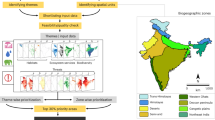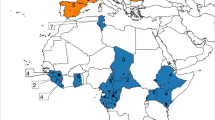Abstract
National parks and reserves are globally popular approaches to protecting biodiversity and the supply of ecosystem services. Because these protected areas limit agricultural development and exploitation of natural resources, they are frequently opposed in developing nations where reducing poverty is an important social objective. Conservation advocates argue that protected areas can alleviate poverty by supplying ecosystem services, promoting tourism and improving infrastructure. Thus ‘win-win’ scenarios may be possible in which ecosystems and their services are protected and poverty is alleviated. Previous studies (Andam et al. in Proc Natl Acad Sci USA 105(42):16089–16094 2008; 2010) suggest that Costa Rica’s protected area system reduced deforestation and alleviated poverty. We demonstrate that these environmental and social impacts were spatially heterogeneous. Importantly, the characteristics associated with the most avoided deforestation are the characteristics associated with the least poverty alleviation. In other words, the same characteristics that limited the conservation effectiveness of protected areas may have improved the social welfare impacts of these areas. These results suggest that ‘win-win’ efforts to protect ecosystems and alleviate poverty may be possible when policymakers are satisfied with low levels of each outcome, but tradeoffs exist when more of either outcome is desired.
Similar content being viewed by others
References
Abadie A, Drukker D, Herr J, Imbens G (2004) Implementing matching estimators for average treatment effects in Stata. Stata J 4: 290–311
Abadie A, Imbens G (2006) Large sample properties of matching estimators for average treatment effects. Econometrica 74(1): 235–267
Adams W, Aveling R, Brockington D, Dickson B, Elliott J, Hutton J, Roe D, Vira B, Wolmer W (2004) Biodiversity conservation and the eradication of poverty. Science 306(5699): 1146–1149
Andam KS, Ferraro PJ, Pfaff A, Sanchez-Azofeifa G, Robalino JA (2008) Measuring the effectiveness of protected area networks in reducing deforestation. Proc Natl Acad Sci USA 105(42): 16089–16094
Andam K, Ferraro P, Sims K, Healy A, Holland M (2010) Protected areas reduced poverty in Costa Rica and Thailand. Proc Natl Acad Sci USA 107(22): 9996
Cavatassi R, Davis B, Lipper L (2004) Estimating poverty over time and space: construction of a time-variant poverty index for Costa Rica. ESA working paper
Coad L, Campbell A, Miles L, Humphries K (2008) The costs and benefits of protected areas for local livelihoods: a review of the current literature. World Conservation Monitoring Centre working paper, UNEP
Cropper M, Puri J, Griffiths C (2001) Predicting the location of deforestation: the role of roads and protected areas in North Thailand. Land Econ 77(2): 172
Crump R, Hotz V, Imbens G, Mitnik O (2008) Nonparametric tests for treatment effect heterogeneity. Rev Econ Stat 90(3): 389–405
Crump R, Hotz V, Imbens G, Mitnik O (2009) Dealing with limited overlap in estimation of average treatment effects. Biometrika 96(1): 187
de Camino Velozo R, de Camino R, Segura O, Arias L, Perez I (2000) Costa Rica: forest strategy and the evolution of land use. World Bank Publications, Washington, DC
Duffy-Deno K (1998) The effect of federal wilderness on county growth in the intermountain western United States. J Reg Sci 38(1): 109–136
Gindling T, Terrell K (2004) Legal minimum wages and the wages of formal and informal sector workers in Costa Rica. William Davidson Institute Working Papers Series, University of Michigan
Ho D, Imai K, King G, Stuart E (2007) Matching as nonparametric preprocessing for reducing model dependence in parametric causal inference. Polit Anal 15: 199–236
Holland P (1986) Statistics and causal inference. J Am Stat Assoc 81(396): 945–960
Imbens G (2004) Nonparametric estimation of average treatment effects under exogeneity: A review. Rev Econ Statist 86(1): 4–29
Imbens G, Wooldridge J (2009) Recent developments in the econometrics of program evaluation. J Econ Lit 47(1): 5–86
Joppa L, Pfaff A (2010) Reassessing the forest impacts of protection: the challenge of nonrandom location and a corrective measure. Ann N Y Acad Sci 1185: 135–139
Lewis D, Hunt G, Plantinga A (2002) Public conservation land and employment growth in the northern forest region. Land Econ 78(2): 245
Lewis D, Hunt G, Plantinga A (2003) Does public lands policy affect local wage growth. Growth Change 34(1): 64–86
Manski C (2005) Social choice with partial knowledge of treatment response. Springer, New York
MEA (2005) Ecosystems and human well-being. Millennium Ecosystem Assessment. Island Press
Pfaff A, Robalino J, Sanchez-Azofeifa G, Andam K, Ferraro P (2009) Park location affects forest protection: land characteristics cause differences in park impacts across Costa Rica. BE J Econom Anal Policy 9(2): 5
Reibel M (2007) Geographic information systems and spatial data processing in demography: a review. Population Res Pol Rev 26(5): 601–618
Robalino J (2007) Land conservation policies and income distribution: who bears the burden of our environmental efforts. Environ Dev Econ 12(04): 521–533
Rosenbaum P (2002) Observational studies. Springer
Rubin B, Hyman G (2000) The extent and economic impacts of soil erosion in Costa Rica. In: CAS Hall, C Perez, G Leclerc (eds) Quantifying sustainable development: the future of tropical economies. Academic Press, San Diego
Sims KRE (2010) Conservation and development: evidence from Thai protected areas. J Environ Econ Manage (Forthcoming)
Somanathan E, Prabhakar R, Mehta B (2009) Decentralization for cost-effective conservation. Proc Natl Acad Sci USA 106(11): 4143
Wilkie D, Morelli G, Demmer J, Starkey M, Telfer P, Steil M (2006) Parks and people: assessing the human welfare effects of establishing protected areas for biodiversity conservation. Conserv Biol 20(1): 247
WDPA (2009) World database on protected areas: 2009 annual release. http://www.wdpa.org/AnnualRelease.aspx
Author information
Authors and Affiliations
Corresponding author
Rights and permissions
About this article
Cite this article
Ferraro, P.J., Hanauer, M.M. Protecting Ecosystems and Alleviating Poverty with Parks and Reserves: ‘Win-Win’ or Tradeoffs?. Environ Resource Econ 48, 269–286 (2011). https://doi.org/10.1007/s10640-010-9408-z
Accepted:
Published:
Issue Date:
DOI: https://doi.org/10.1007/s10640-010-9408-z




